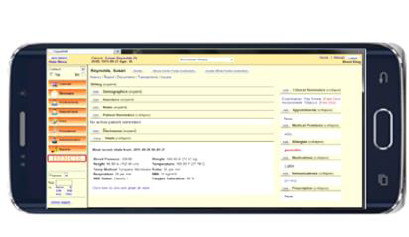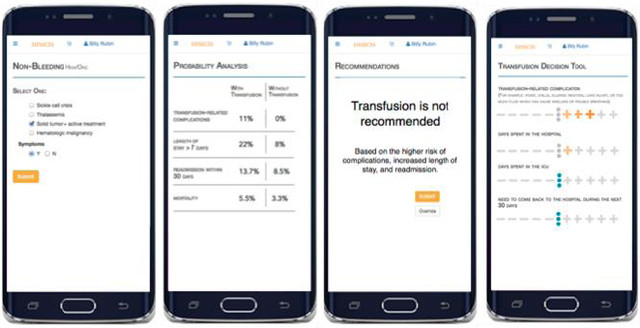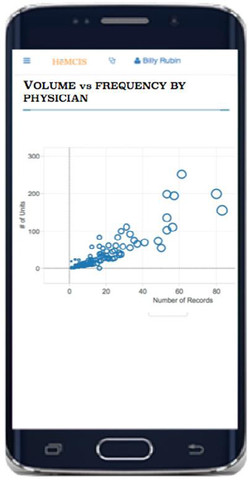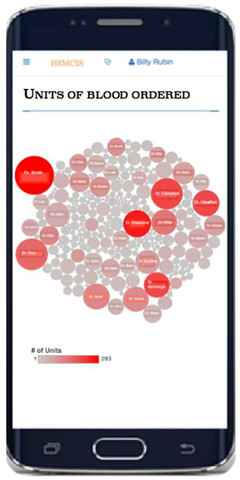About our project
Technology: when it saves you time, it is efficient; when it saves you money, it is judicious; when it saves lives, it is indispensable. When technology does all three, it is game-changing. Klincis’s technology is a game-changer.
The Problem We Solve
Medical errors: they’re an incalculable problem in every hospital and clinic despite the well-intentioned protocols set up to prevent them. Errors are costly in more ways than one. There’s the financial aspect, yes, but the cost to human life and safety is vast. In fact, hospital errors comprise the fourth leading cause of death after heart attack, cancer, and stroke. They are sometimes classified as “unintentional accidents” and come in many forms. For instance, overprescription of medications and procedures are considered a type of medical error, as they can lead to patient safety issues and costly impacts to an institution’s bottom line. Let’s take blood transfusions as an example: more than 5 million people get blood transfusions per year—20% to 50% outside of clinical guidelines. While transfusions are undeniably life-saving in the right situations, they can also significantly prolong length of stay, increase mortality by 0.5%, and cost $1-$3 million per year (for a 400-bed hospital). Sometimes clinicians may not know definitively when a transfusion is a necessity and when it is not needed, thus they err on the side of transfusing. In short, this type of overprescription is reflected as high costs and poor quality.
Physicians have limited access to guidelines, and those guidelines that do exist are not always generalizable. To add to this, ambiguity arises when patients have multiple diseases and are on multiple treatments. Physicians do not always have all the necessary information at the point of care to make an informed, time-sensitive decision that is immediately actionable. There are currently no point-of-care shared decision-making tools that provide treatment options and their consequences. As an example for the above scenario, a physician was trying to decide whether to transfuse an elderly man with kidney failure, heart failure, and a low hemoglobin during a complicated hospital admission. There are guidelines for transfusion in kidney failure and transfusion thresholds for heart failure, but no clear guidance for a patient with this combination of conditions. In the absence of definitive evidence, the physician decided to transfuse the patient that day and brought the consent form to the patient. After a brief talk, both physician and patient were frustrated: the physician because the effect of transfusion on the patient’s well-being was unknown (and thus it was just a guessing game) and the patient because he had no understanding of just how little knowledge was behind this and many other treatment decisions.
Our Solution
Imagine the following at the point of care:
- Physicians can access a clinical decision support solution (CDSS) that illustrates important odds of a treatment.
- Physicians have all the necessary information and data points available from the EMR, sensors, and wearable devices.
- The CDSS integrates into the physician’s workflow and can be accessed through any device wherever the clinician may be.
There’s no more imagining. Klincis’s CDSS platform takes a patient’s data and predicts an outcome for a specific treatment decision. Our flagship product, Hēmcis, applies this to blood transfusions by making a recommendation at the point of care on whether to transfuse a patient. Because blood transfusion decisions can confound a physician at times—in that there are many scenarios in which a cut-and-dry answer is missing as to whether the patient actually needs one—Hēmcis will help them decide with evidence-based data. The physician who lacks the experience and/or clinical knowledge to make such a decision without supporting evidence—something that is rarely available in immediate situations—will now have the tools to do just that.
Klincis is simultaneously working to expand our CDSS platform to other therapeutic areas, including hospital-acquired infections, antibiotics, mortality predictions, and pain management.
Why We Care
Founders: an internal medicine physician, a clinical pharmacist, a medical writer, and a techie were brought together through typical New York moments like a walk by the Hudson, a 6-train ride, and dinners at our favorite restaurants. We all shared a common trait: kindness and empathy towards people. We get annoyed when patients are referred to as a condition being treated. We are motivated by a deep desire to help a person “heal” rather than just be “treated.” We also agree that many times it is important to not do anything than to just do “something.” We spoke to more than 275 physicians and hospital administrators – the majority of whom were frustrated and revealed that their institutions lose money to unnecessary blood transfusions, imaging requests, antibiotics, and errors. We met patients who were in the dark about the treatment they were getting, and many were overwhelmed with posttreatment bills. We met nurses who said they witnessed errors that were not reported.
When NYC Health and Hospitals Corporation first began to switch to the Epic EMR system, there was an opportunity to provide technology transformation assistance when the CMO asked Om to work with their hospital. When we injected ourselves into the thick of how residents and physicians in community hospitals were struggling to use the few resources to help the most people possible, it dawned on us that the providers need help in making the most optimal decisions to save lives.
The National Science Foundation I-Corps Program conducted by Columbia Business School and NYU Stern School of Business accepted Om, who completed the program by defining a successful scalable business model. Klincis was a winner at a MedStartr pitch contest and we were semifinalists in a New York Digital Health Accelerator program. We received AWS credits for our cloud-hosting, and we closed a termsheet in India from a major health network. We now have a viable product that was shown to reduce 19% of blood orders at a major NYC hospital. We have come a long way from wanting to change healthcare to developing a product that reduces costs and saves lives while retaining the human element of relationship between doctor and patient.
We are now about to launch a pilot program with Mount Sinai, which is needed to clinically show that our platform can reduce unnecessary treatments with evidence from data in a prospective clinical study. We would like to cover the costs of integration with their Epic system and pay for key resources and time to produce the data.
How Hēmcis Works


 |
 |
The same physician from our earlier example now has a link in the EMR for Hēmcis. Hēmcis is also triggered by events such as a reduction in hemoglobin or a change in blood pressure or heart rate, etc. All relevant labs (hemoglobin, creatinine levels, vitals) are available on a single screen for the physician to review—all at the point of care. The logic behind Hēmcis’s predictive models recommends to the physician the odds of outcomes such as length of stay, cost of stay, complication risk, etc, for transfusion treatment. In this case example, a different decision would have been made due to the available information from Hēmcis; the physician would have decided to not transfuse based on higher risk of complications for that particular patient. With Hēmcis, the physician also has a pictographic tool to enable an easy-to-understand discussion about the decision with the patient. The analytics dashboard is helpful for physicians and administrators to compare aggregate outcome trends by patients and doctors for publication and reporting.
Clinical Proof to Date
Our preliminary data from a major hospital in Manhattan showed that Hēmcis can reduce 19% of excess orders. We are a startup focused on leveraging data and analytics to improve patient outcomes. To that end, we have developed the beta version of our product. With the help of Medstartr, we plan to utilize our technology in early pilot clinical trials aimed at reducing overprescription.
FDA Status
We do not expect to be required to need Food and Drug Administration approval for our clinical decision support system. Recent FDA policy stand on CDSS is available here: http://cdscoalition.org/positions/. Guidelines suggest that our application will be of Class I status and will not require further risk assessment or regulatory oversight.
How We Help Patients
Risk scores bridge the gap in knowledge and bring objective decision-making to clinical care. They provide clear odds of both short- and long-term outcomes for each specific patient, eliminating the need for “guessing.” Visual representations of the benefits and risks of transfusions in a patient-friendly format allow the physician and patient to look at the information together and jointly decide on the best option.
Blood transfusions can be life-saving. However, in many cases, the need for transfusion is not very clear and the risks and benefits of transfusion need to be weighed. Excess transfusions expose patients to dangerous complications, including allergic reactions, fluid overload (leg swelling, difficulty breathing), lung injury, infections, a longer hospital stay, and waste of a very precious resource.
Are you a blood donor? Together we can help ensure that blood donations are used wisely and responsibly!
How We Help Hospitals, Institutions, and/or Medical Facilities
Our products help meet short-term metrics and long-term visions and help institutions implement data-driven initiatives, generating lasting strategic value. Our goal is to transform care back to a patient-centric model with care accountability, transparency, and patient empowerment to reduce overprescription, which would improve outcomes for both patient and institution. We utilize best practices from other verticals, such as an agile product development and data insights, to bring healthcare up to speed with other sectors.
We eliminate data-related ambiguity so that providers have more time with their patients and are able to use available tools more cost-effectively while meeting hospital metrics and regulatory goals set forth by ONC, CMS, and the Affordable Care Act.
How We Help Our Partners
We welcome the opportunity to connect with partners
1. Regional extension centers (such as NJ-HITEC), ACOs, hospital innovation funds, and other agencies that are interested in promoting technology adoption. Our application will help healthcare institutions meet the Meaningful Use requirements and improve quality metrics and hospital ratings.
2. Insurance actuaries can use Klincis’s models developed for clinicians to process claims data to optimize payout.
3. Development partners have plenty of projects in the pipeline. If you are a web application development shop, a data-mining shop, or an IT infrastructure shop, please contact us to join hands in this healthcare revolution.
4. Contract research organizations benefit from our clinical trials design projects. We plan to set up clinical trials for each of our newly developed product lines.
5. Contract sales organizations benefit from revenue-sharing contracts with our group.
How We Will Spend Your Contributions
A pilot test will be conducted to determine the system’s clinical validity and effectiveness. The specific aim of the pilot is to achieve a 10% reduction in transfusions.
The pilot implementation will be carried out as follows:
Step 1: Integrate the validated model and Hēmcis application with Epic. Encrypted and encapsulated data is obtained using HL7 from Epic and stored in HIPAA-secure cloud servers. Real-time recommendations will be transmitted back to Epic.
Step 2: A randomized controlled trial will be conducted at Mount Sinai’s Emergency Department to establish return on investment.
Why Klincis Will Be a Great Investment
Klincis’s flagship product, Hēmcis, will have a strong impact on the health of New Yorkers because overuse of transfusions and similar ambiguous overtreatment leads to unnecessary patient harm, prolonged hospitalizations, and increased mortality. Optimizing transfusions will help minimize these risks, freeing up hospital beds, decreasing hospital-associated risks, and ultimately improving patient care and outcomes.
Market: Hēmcis is a clinical decision support product; the market for healthcare analytics and CDSS is projected to be $23.8 billion by 2020 (according to Mordor Intelligence). Currently there are a total of 5,723 hospitals in the United States and 289 in the NYC tristate area. Hēmcis is a new, innovative entrant into the decision support market. With an anticipated adoption rate of 2%, our projected market value will be 6*750,000 = $4.5 million in the next 2 years; with an adoption rate of 5%, our market value would be 15*750,000 = $11.25 million in the next 2 years.
Competition: The predictive models behind Hēmcis cannot be built by just any group, as they need an amalgamation of clinical, mathematical, technological, and operational acumen. To our knowledge, no other companies offer prescriptive analytics within an extensible decision support platform that is integrated within the physician’s workflow.
Team: The management team is led by Chief Executive Officer Om Vadlapatla, who founded the company in 2012. He has spent a 1.5 decades working in the areas of development, technology, and business strategy, consulting with numerous organizations to improve technology systems and optimize businesses. Om has delivered high-risk, capital-intensive complex solutions in verticals as diverse as healthcare, energy, telecommunications, finance, IT, multimedia content development, and semiconductors. We bring in all the necessary skills to the team.
Who We Are
Founder: Om Vadlapatla
Chief Medical Officer: Sowmya Josyula, MD, MPH
Managing Director: Nancy Salerno
How to Find Us
Twitter: @klincisCDS
Facebook: http://www.facebook.com/klincis
Blog: http://go.klincis.com/vitalblog
- Have a question? If the info above does not help, you can ask the project creator directly.
Rewards
For $5 or more
2 Supporter(s)
Show the world you care about this problem and want it solved. In return we will do our best to solve it and know we are doing it for you. Here and on our website, in perpetuity, we will list you and who you are honoring with your donation as a FOUNDING SPONSOR with our sincere thanks.
For $25 or more
1 Supporter(s)
Show the world you care about this problem and want it solved. In return we will do our best to solve it and know we are doing it for you. Here and on our website, in perpetuity, we will list you and who you are honoring with your donation as a FOUNDING SPONSOR with our sincere thanks. Plus you will get the Klincis t-shirt to show everyone you are part of the solution!
For $50 or more
0 Supporter(s)
Help your patients get better faster with our CDSS and show the world you care about this problem and want it solved. In return we will do our best to solve it and know we are doing it for you. Here and on our website, in perpetuity, we will list you and your practice as PIONEER SPONSORS with our sincere thanks.
For $100 or more
3 Supporter(s)
Show the world you care about this problem and want it solved. In return we will do our best to solve it and know we are doing it for you. Here and on our website, in perpetuity, we will list you and who you are honoring with your donation as a FOUNDING SPONSOR with our sincere thanks. Plus you will get the Klincis t-shirt to show everyone you are part of the solution! Also, we’ll send you a carton of delicious, farm-fresh organic fruits and vegetables.
For $150 or more
0 Supporter(s)
Help your patients get better faster with our CDSS and show the world you care about this problem and want it solved. In return we will do our best to solve it and know we are doing it for you. Here and on our website, in perpetuity, we will list you and your practice as PIONEER SPONSORS with our sincere thanks. Plus, we will send you a personalized canvas print.
For $200 or more
0 Supporter(s)
Help your patients get better faster with our CDSS and show the world you care about this problem and want it solved. In return we will do our best to solve it and know we are doing it for you. Here and on our website, in perpetuity, we will list you and your practice as PIONEER SPONSORS with our sincere thanks. Plus, we will send you a personalized canvas print. And a free 1-month trial to our transfusion guidelines app!
For $250 or more
0 Supporter(s)
Show the world you care about this problem and want it solved. In return we will do our best to solve it and know we are doing it for you. Here and on our website, in perpetuity, we will list you and your practice as an INSTITUTIONAL SPONSOR with our sincere thanks.
For $500 or more
0 Supporter(s)
Show the world you care about this problem and want it solved. In return we will do our best to solve it and know we are doing it for you. Here and on our website, in perpetuity, we will list you and your practice as an INSTITUTIONAL SPONSOR with our sincere thanks. Plus, spread the word with partner institutions, getting on our credits program. With these credits you can pay for a subscription of CDSS SaaS, or use them towards Klincis’s services.
For $1000 or more
0 Supporter(s)
Show the world you care about this problem and want it solved. In return we will do our best to solve it and know we are doing it for you. Here and on our website, in perpetuity, we will list you and your practice as CORPORATE SPONSORS with our sincere thanks.
For $2000 or more
0 Supporter(s)
Show the world you care about this problem and want it solved. In return we will do our best to solve it and know we are doing it for you. Here and on our website, in perpetuity, we will list you and your practice as CORPORATE SPONSORS with our sincere thanks. Plus we will publish your white papers and use cases on our website!
For $2500 or more
0 Supporter(s)
Show the world you care about this problem and want it solved. In return we will do our best to solve it and know we are doing it for you. Here and on our website, in perpetuity, we will list you and your practice as an INSTITUTIONAL SPONSOR with our sincere thanks. Plus, spread the word with partner institutions, getting on our credits program. With these credits you can pay for a subscription of CDSS SaaS, or use them towards Klincis’s services. Become an early adopter! Get a freemium subscription to our product.
For $3000 or more
0 Supporter(s)
Show the world you care about this problem and want it solved. In return we will do our best to solve it and know we are doing it for you. Here and on our website, in perpetuity, we will list you and your practice as CORPORATE SPONSORS with our sincere thanks. Plus we will publish your white papers and use cases on our website! Also, we’ll help with your business travel by providing you with a roundtrip plane ticket in the contiguous USA.
No updates found .
No comments found .
Login to post your comment! Click here to Login
backed on 04/26/2016
backed on 04/25/2016
backed on 04/25/2016
backed on 04/25/2016
backed on 04/24/2016
backed on 04/23/2016
backed on 04/23/2016
backed on 04/22/2016
backed on 04/20/2016
backed on 04/17/2016
backed on 04/16/2016
backed on 04/15/2016
backed on 04/15/2016
backed on 04/15/2016
backed on 04/15/2016
backed on 04/14/2016

